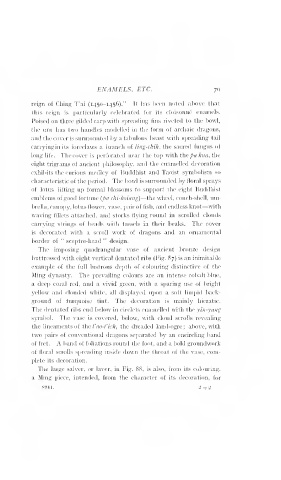Page 277 - Chinese Art, Vol II By Stephen W. Bushell
P. 277
ENAMELS, ETC. 79
reign of Ching T'ai (1450-1456)." It has been noted above that
this reign is particularly celebrated for its cloisonne enamels.
Poised on three gilded carp with spreading fins riveted to the bowl,
the urn has two handles modelled in the form of archaic dragons,
and the cover is surmounted by a fabulous beast with spreading tail
carrying in its foreclaws a branch of ling-chih, the sacred fungus of
long life. The cover is perforated near the top with the pa kiia, the
eight trigrams of ancient philosophy, and the enamelled decoration
exhibits the curious medley of Buddhist and Taoist symbolism so
characteristic of the period. The bowl is surrounded by floral sprays
of lotus lifting up formal blossoms to support the eight Buddhist
emblems of good fortune {pa chi-hsiang)—the wheel, conch-shell, um-
brella, canopy, lotus-flower, vase, pair of fish, and endless knot—with
waving fillets attached, and storks flying round in scrolled clouds
carrying strings of beads with tassels in their beaks. The cover
is decorated with a scroll work of dragons and an ornamental
border of " sceptre-head " design.
The imposing quadrangular vase of ancient bronze design
buttressed with eight vertical dentated ribs (Fig. 87) is an inimitable
example of the full lustrous depth of colouring distinctive of the
Ming dynasty. The prevailing colours are an intense cobalt blue,
a deep coral red, and a vivid green, with a sparing use of bright
yellow and clouded white, all displayed upon a soft limpid back-
ground of turquoise tint. The decoration is mainly hieratic.
The dentated ribs end below in circlets enamelled with the yin-yang
symbol. The vase is covered, below, with cloud scrolls revealing
the lineaments of the t'ao-fich, the dreaded land-ogre ; above, with
two pairs of conventional dragons separated by an encircling band
of fret. A band of foliations round the foot, and a bold groundwork
of floral scrolls spreading inside down the throat of the vase, com-
plete its decoration.
The large salver, or laver, in Fig. &8, is also, from its colouring,
a Ming piece, intended, from the character of its decoration, for
S941. 2 li 2

